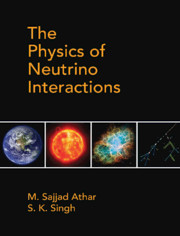Book contents
- Frontmatter
- Dedication
- Contents
- List of Figures
- List of Tables
- Preface
- Acknowledgments
- Chapter 1 Neutrino Properties and Its Interactions
- Chapter 2 Relativistic Particles and Neutrinos
- Chapter 3 Quantization of Free Particle Fields
- Chapter 4 Interacting Fields and Relativistic Perturbation Theory
- Chapter 5 Phenomenological Theory I: Nuclear β-decays and Weak Interaction of Leptons
- Chapter 6 Phenomenological Theory II: Weak Decays of Hadrons
- Chapter 7 Gauge Field Theories and Fundamental Interactions
- Chapter 8 Unified Theory of Electroweak Interactions
- Chapter 9 Neutrino and Electron Scattering from Point Particles
- Chapter 10 Neutrino scattering Cross Sections from Hadrons: Quasielastic Scattering
- Chapter 11 Neutrino Scattering from Hadrons: Inelastic Scattering (I)
- Chapter 12 Neutrino Scattering from Hadrons: Inelastic Scattering (II)
- Chapter 13 Neutrino Scattering from Hadrons: Deep Inelastic Scattering
- Chapter 14 Weak Quasielastic v(⊽)-nucleus Scattering
- Chapter 15 Inelastic Scattering of (Anti)neutrinos from Nuclei
- Chapter 16 Deep Inelastic Scattering of (Anti)neutrinos from Nuclei
- Chapter 17 Neutrino Sources and Detection of Neutrinos
- Chapter 18 Neutrino Mixing and Oscillations
- Chapter 19 Neutrino Astrophysics and the Synthesis of Elements
- Chapter 20 Neutrino Interactions Beyond the Standard Model
- Appendices
- Appendix A Lorentz Transformation and Covariance of the Dirac Equation
- Appendix B Cabibbo Theory
- Appendix C Some Properties of Pauli and Dirac Matrices and Spin Density Matrices
- Appendix D Leptonic and Hadronic Tensors
- Appendix E General Expression for the Total Scattering Cross Section and Decay Rates
- Appendix F Expressions of N(q2), the Coefficients of the Polarization Observables
- References
- Index
Chapter 3 - Quantization of Free Particle Fields
Published online by Cambridge University Press: 22 May 2020
- Frontmatter
- Dedication
- Contents
- List of Figures
- List of Tables
- Preface
- Acknowledgments
- Chapter 1 Neutrino Properties and Its Interactions
- Chapter 2 Relativistic Particles and Neutrinos
- Chapter 3 Quantization of Free Particle Fields
- Chapter 4 Interacting Fields and Relativistic Perturbation Theory
- Chapter 5 Phenomenological Theory I: Nuclear β-decays and Weak Interaction of Leptons
- Chapter 6 Phenomenological Theory II: Weak Decays of Hadrons
- Chapter 7 Gauge Field Theories and Fundamental Interactions
- Chapter 8 Unified Theory of Electroweak Interactions
- Chapter 9 Neutrino and Electron Scattering from Point Particles
- Chapter 10 Neutrino scattering Cross Sections from Hadrons: Quasielastic Scattering
- Chapter 11 Neutrino Scattering from Hadrons: Inelastic Scattering (I)
- Chapter 12 Neutrino Scattering from Hadrons: Inelastic Scattering (II)
- Chapter 13 Neutrino Scattering from Hadrons: Deep Inelastic Scattering
- Chapter 14 Weak Quasielastic v(⊽)-nucleus Scattering
- Chapter 15 Inelastic Scattering of (Anti)neutrinos from Nuclei
- Chapter 16 Deep Inelastic Scattering of (Anti)neutrinos from Nuclei
- Chapter 17 Neutrino Sources and Detection of Neutrinos
- Chapter 18 Neutrino Mixing and Oscillations
- Chapter 19 Neutrino Astrophysics and the Synthesis of Elements
- Chapter 20 Neutrino Interactions Beyond the Standard Model
- Appendices
- Appendix A Lorentz Transformation and Covariance of the Dirac Equation
- Appendix B Cabibbo Theory
- Appendix C Some Properties of Pauli and Dirac Matrices and Spin Density Matrices
- Appendix D Leptonic and Hadronic Tensors
- Appendix E General Expression for the Total Scattering Cross Section and Decay Rates
- Appendix F Expressions of N(q2), the Coefficients of the Polarization Observables
- References
- Index
Summary
Introduction
The concept of associating particles with fields originated during the studyof various physical phenomena involving electromagnetic radiation. Forexample, the observations and theoretical explanations of the black bodyradiation by Planck, the photoelectric effect by Einstein, and thescattering of a photon off an electron by Compton established thatelectromagnetic radiation can be described in terms of “discretequanta of energy” called photon, identified as a massless particle ofspin 1. Consequently, Maxwell's equations of classicalelectrodynamics, describing the time evolution of the electric and magneticfields are interpreted to be the equations of motion of the photon, writtenin terms of the massless spin 1 electromagnetic field. Later, thequantization of the electromagnetic field was formulated to explain theemission and absorption of radiation in terms of the creation andannihilation of photons during the interaction of the electromagnetic fieldwith the physical systems. The concept of treating photons as quanta of theelectromagnetic fields was successful in explaining the physical phenomenainduced by the electromagnetic interactions; methods of field quantizationwere used leading to quantum electrodynamics (QED), the quantum field theoryof electromagnetic interactions. The concept was later generalized by Fermi[23, 207] and Yukawa [208, 209] to formulate, respectively, the theory ofweak and strong interactions in analogy with the theory of QED.
In order to describe QED, the quantum field theory of electromagnetic fieldsand their interaction with matter, in terms of the massless spin 1 fieldscorresponding to photons, the equations of motion of should be fullyrelativistic. This requires the reformulation of classical equations ofmotion for the fields to obtain the quantum equations of motion for thefields and find their solutions, in case of free fields as well as fieldsinteracting with matter. This is generally done using perturbation theoryfor which a relativistically covariant perturbation theory is required.
The path of transition from a classical description of fields to a quantumdescription of fields, requiring the quantization of fields, their equationsof motion, propagation, and interaction with matter involves understandingmany new concepts and mathematical methods. For this purpose, the Lagrangianformulation for describing the dynamics of particles and their interactionwith the fields is found to be suitable.
Information
- Type
- Chapter
- Information
- The Physics of Neutrino Interactions , pp. 96 - 138Publisher: Cambridge University PressPrint publication year: 2020
